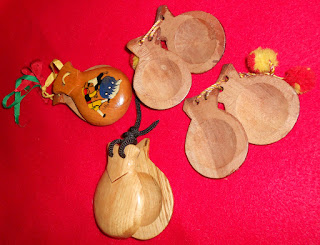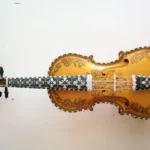
The castanets are a musical instrument of the percussion family, they look like concave shells connected by a string, and they are generally made of hard wood. The origins of the instrument, such as the musical practice of clicking elements to produce sounds for musical purposes, are unknown. It’s been around since ancient times. Ancient Egyptians and ancient Greeks joined sticks to create music for dance that was later replaced by bones and spoons in other cultures. Baskets in their current form appear to have started in Spain, with a Spanish dancer wearing a set in each hand while making clicks to accompany your dance.
Castanets are commonly used in the flamenco dance.
The word ‘castanet’ is derived from the Spanish word ‘castaina’ which means ‘chestnut’.
Spanish folk dance “Sevillanas” is the style typically performed using castanet.
The Spanish have other words for castanets as well including pulgaretes and platillos.
During the baroque period, castanets were featured prominently in dances.
Castanets are referred to as pulgaretes when they are attached to the dancers’ thumbs.
The practice of clicking hand-held sticks together to accompany dancing is ancient, and was practiced by both the Greeks and the Egyptians. In more modern times, the bones and spoons used in Minstrel show and jug band music can also be considered forms of the castanet.
When playing the castanets the musician rests one clapper of the set in the palm of the hand, and links the string around their thumb. They use their fingertips to strike the other clapper of the set against the clapper resting in the palm to create sound.
One pair is held in each hand, with the string hooked over the thumb and the castanets resting on the palm with the fingers bent over to support the other side.
Some musicians use other techniques to create sound with castanets as well.
Each pair will make a sound of a slightly different pitch.
Women usually use the smaller castanets as the instrument should fit in the palm of the hand. Men usually use the larger castanets because their hands can accommodate the larger size.
When used in an orchestral or jug band setting, castanets are sometimes attached to a handle, or mounted to a base to form a pair of machine castanets.
Smaller castanets produce a crisp, higher tone, while larger castanets produce a rich, mellow, lower tone.
Handle castanets were developed for use in orchestral music.
Cheaper wood or plastic castanets are inexpensive and can be found for as little as $10.
he smaller sizes, usually used by women, produce a higher tone that is crisper in quality; the larger sizes, usually used by men, produce a lower tone that is richer and more mellow in quality.
Castanets that are handcrafted for professional musicians are made of more expensive materials such as hardwood or composite and cost much more – as much as $400 a set.
Mass-produced castanets made of poor-quality wood or plastic cost less than $10 a set.
Some castanets are made for novelty purposes from materials that are not suitable to produce the quality of sound desired by musicians. Novelty castanets are often made of bronze, silver, gold, marble, crystal, and even ivory.
Custom-made sets that are handcrafted from high-quality material, such as hard-woods and composites, to suit an individual performer cost $100-400.
Quality castanets are usually made of hardwoods such as oak, pomegranate, ebony, rosewood, and granadillo.
Novelty castanets have been made from ivory, marble, crystal, gold, silver, bronze, and aluminum, but few of these are musically useful.
Many professional castanets today are made of synthetic materials such as Micarta – a laminated material made similar to the method of creating fiberglass. Layers of fiber cloth are bonded with resin and heat and pressure are applied to create a product similar to hardwoods.
The traditional material used for good castanets has been very hard, but not brittle, wood such as granadillo, rosewood, ebony, pomegranate, or oak.
Although traditionally castanets were made in the shape of a concave shell, today they are also made in other shapes such as rectangular, square, or even triangular.
Most professional-quality castanets are currently made from a synthetic, laminated material such as Micarta.
The sounds made by castanets comes from their size, depth of hollow (or concave shape), and contact area at the tip of the castanet clappers.
Cotton strings are generally used to hinge together the two clappers of a pair of castanets.
Dancers use castanets to accompany their dancing but they are being used in other music as well – even in orchestras today.
Castanets are commonly shaped like a clam shell that is circular or slightly oval, with an extension on one side for the hinge holes.
Some castanets are mounted on wooden handles, freeing up the musicians hands from the strings. Instead of strings they clappers are attached by elastic cords. This makes it easy for the musician to pick up the wooden handle and clap the castanets and set them back down quickly when not being played.
Occasionally, however, castanets are made in more novel shapes like squares, rectangles, or triangles.









